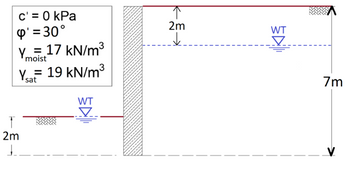
Structural Analysis
6th Edition
ISBN: 9781337630931
Author: KASSIMALI, Aslam.
Publisher: Cengage,
expand_more
expand_more
format_list_bulleted
Question
For the retaining wall shown below, determine the passive earth pressure coefficient if the wall friction is equal to 15 degrees
g = 9.81

Transcribed Image Text:c' = 0 kPa
4'=30°
2m
Y = 17 kN/m³
moist
Ysa 19 kN/m³
WT
✓
2m
WT
☑
7m
Expert Solution
This question has been solved!
Explore an expertly crafted, step-by-step solution for a thorough understanding of key concepts.
Step by stepSolved in 2 steps

Knowledge Booster
Similar questions
- When movement of a wall under the earth pressures from the backfill was prevented the coefficient of earth pressure was recorded as 0.5. The ratio of the coefficient of passive and active earth pressure of the backfill isarrow_forwardFind the active lateral force/unit of width and the point of application for a verticalretaining wall with the following data: γ = 110 pcf, Φ= 36° , C = 0 psf, H = 18 ft; Using theCoulomb equation with δ = 20° and (a) horizontal backfill, (b) backfill slope 10° , and (c)backfill slope -10°arrow_forwardThe following figure shows a section of an anchored retaining wall embedded into a saturated stiff clay layer. The sand has a unit weight of = 18 kN/m³, c' = 0 kPa and o' = 34º. The clay has a unit weight of = 20 kN/m³, c₁ = 80 kPa and = 0°. A uniform pressure of 40 kPa is applied on the soil surface. The short term stability of the wall is considered in an undrained analysis. Use the Rankin's theory of lateral earth pressure to determine the active and passive horizontal stresses. You should apply the requirements of AS 4678 and the partial factors of safety method in estimation of soil pressures. Assume the soil is in-situ and use a structural classification factor of ₁ = 1. 3m 1m Water table 1.5m 40 kPa Not to Scale Sand Clay Taarrow_forward
- You are reviewing the stability of the gravity wall when the backfill has properties with: Φ' = 35° and γt = 16.5 kN/m3. The soils in front of the wall is ignored in the stability analysis, and the drainage blanket has no influence. Assume the coefficient of the base friction is, μ = 0.3, and the unit weight of concrete is γc = 23.5 kN/m3. a) draw the lateral earth pressure diagram and determine the total active lateral force. b) determine the factor of safety against overturning. c) determine the factor of safety against sliding.arrow_forwardQ-1: Figure-1 shows a 4.5-m-high retaining wall. The wall is restrained from yielding. Then find, the following conditions: A) Completely dry soil (no ground water) B) Completely saturated soil systemarrow_forwardA retaining wall is 4 meters tall and retains granular soil having a drained friction angle of 32 degrees and a total unit weight of 18.5 kN/m³. The groundwater table is located at mid-height of the wall. Prepare a simplified scaled drawing showing the wall, ground surface, groundwater table and all active earth and water pressure diagrams. State your assumption of wall friction. Label all heights and depths and provide calculated values for the pressures at the top and bottom of each pressure polygon. Calculate the total force acting on the back of the wall in pounds per foot of wall, and the location of the resultant force above the toe of wall. Include all units.arrow_forward
arrow_back_ios
arrow_forward_ios
Recommended textbooks for you

 Structural Analysis (10th Edition)Civil EngineeringISBN:9780134610672Author:Russell C. HibbelerPublisher:PEARSON
Structural Analysis (10th Edition)Civil EngineeringISBN:9780134610672Author:Russell C. HibbelerPublisher:PEARSON Principles of Foundation Engineering (MindTap Cou...Civil EngineeringISBN:9781337705028Author:Braja M. Das, Nagaratnam SivakuganPublisher:Cengage Learning
Principles of Foundation Engineering (MindTap Cou...Civil EngineeringISBN:9781337705028Author:Braja M. Das, Nagaratnam SivakuganPublisher:Cengage Learning Fundamentals of Structural AnalysisCivil EngineeringISBN:9780073398006Author:Kenneth M. Leet Emeritus, Chia-Ming Uang, Joel LanningPublisher:McGraw-Hill Education
Fundamentals of Structural AnalysisCivil EngineeringISBN:9780073398006Author:Kenneth M. Leet Emeritus, Chia-Ming Uang, Joel LanningPublisher:McGraw-Hill Education
 Traffic and Highway EngineeringCivil EngineeringISBN:9781305156241Author:Garber, Nicholas J.Publisher:Cengage Learning
Traffic and Highway EngineeringCivil EngineeringISBN:9781305156241Author:Garber, Nicholas J.Publisher:Cengage Learning


Structural Analysis (10th Edition)
Civil Engineering
ISBN:9780134610672
Author:Russell C. Hibbeler
Publisher:PEARSON

Principles of Foundation Engineering (MindTap Cou...
Civil Engineering
ISBN:9781337705028
Author:Braja M. Das, Nagaratnam Sivakugan
Publisher:Cengage Learning

Fundamentals of Structural Analysis
Civil Engineering
ISBN:9780073398006
Author:Kenneth M. Leet Emeritus, Chia-Ming Uang, Joel Lanning
Publisher:McGraw-Hill Education


Traffic and Highway Engineering
Civil Engineering
ISBN:9781305156241
Author:Garber, Nicholas J.
Publisher:Cengage Learning